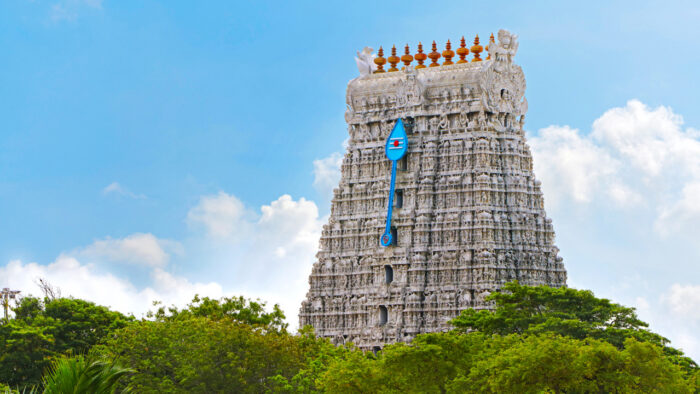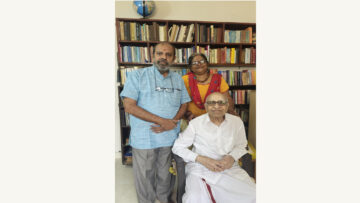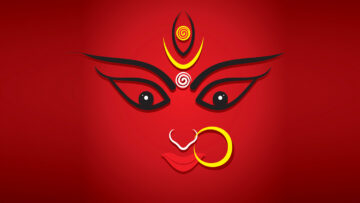The Subramanya Bhujangam is a timeless Sanskrit hymn composed by Sri Adi Shankaracharya in praise of Lord Subramanya, the divine son of Shiva and Parvati. Legend has it that it was composed in the praise of Sri Subramanya Swamy of Tiruchendur. Tiruchendur is a small town in the Thoothukudi district of Tamil Nadu. It is an important pilgrimage centre for all devotees of Lord Skanda. According to a legend in Skanda Purana, it is at Tiruchendur that Lord Subramanya slayed the demon Surapadman. Sri Adi Shankaracharya has written many Stotra-s in praise of various deities. Predominant among them are the Mahishasura-Mardini Stotram, Saundarya Lahari, Lakshmi-Nrisimha Karavalamba Stotram, Vishnu Shat-padi, Ganesh Pancharatnam, Sivananda Lahari. They are all beautiful compositions filled with poetic outbursts of devotion and profound explorations of Advaita Vedanta. Subramanya Bhujangam too is a profound expression of devotion, combining poetic beauty with deep spiritual insight, making it a cherished text for devotees and spiritual seekers alike. Subramanya Bhujangam stands out among Adi Shankaracharya’s major devotional compositions due to its unique link to an actual temple deity, intensely personal outpouring, and deft articulation of the devotee’s heart and challenges. Unlike the other Stotra-s, which highlight philosophical depth and devotional beauty, Subramanya Bhujangam is marked by moving inspiration, relatable emotions, and a heartfelt cry for rescue and solace which connects the devotee directly with the living presence of the deity of Tiruchendur at once.
The Stotram is structured into three distinct thematic sections. The opening section offers praise to the Lord and highlights the importance of invoking Sri Subramanya and seeking refuge in Him. The middle section intricately describes the divine form and attributes of Sri Subramanya. The concluding section consists of heartfelt prayers, earnestly seeking the Lord’s grace and ultimate liberation.
The Call to Refuge
At its core, Subramanya Bhujangam is a heartfelt prayer invoking the blessings and grace of Lord Subramanya, who embodies divine protection, wisdom, and grace. The hymn’s verses reverberate with intense Bhakti, portraying the Lord as a compassionate divine guide who dispels fears and grants spiritual victory. Each shloka resonates with reverence, inspiring the devotee to surrender and seek refuge in the Lord. In today’s chaotic world where our minds are filled with confusions, anxiety, and stress, Subramanya Bhujangam in many of its verses is a direct call to the Lord to come and dispel such negative emotions from our mind. Lord Subramanya is not only the Commander-in-Chief of the army of the Deva-s, but He is also the commander of the inner armies of our mind and intellect ever at war with negative emotions and baser thoughts. Lord Subramanya is a protective deity who not only protects the cosmos from evil entities but also our inner world from negative and degrading influences. Sri Adi Shankaracharya in his Vishnu Sahasranama commentary observes, Austerity, Veda-s, Brahmins, and Knowledge are called Brahman. The Lord is Subramanya because he is very well skilled in protecting these. The essence of Subramanya is a grace that protects the fundamentals of Vedic religion.
The first stanza of the Stotram is a prayer to Lord Ganapati that beautifully captures his divine nature. It describes how, despite always appearing in the form of a child, He has the power to remove even the largest of obstacles. Revered by the five-faced Shiva himself, Ganesha is respected despite his elephant head. He embodies auspiciousness and is worshipped by Brahma, Indra, and other devas who seek his blessings to fulfil their desires. Known as Ganesha, he is worshipped for Sri (wealth), which signifies not just material prosperity but more importantly the wealth of auspicious qualities and the spiritual readiness necessary to approach Lord Skanda. The verse subtly conveys that outward appearances do not decide one’s true capability or worth. It is our inner wisdom and skill that enables us to overcome formidable obstacles and earn genuine respect, regardless of how we may appear externally. This teaching encourages looking beyond surface impressions, recognising that true strength arises from being in harmony with our true nature.
In the second stanza, the Acharya humbly expresses his complete surrender to Lord Subramanya. Though renowned as a master of the scriptures, Adi Shankara confesses that he has no command over words, nor their meanings, and is not skilled in either prose or poetry. Instead, he credits a radiant, six-faced light of consciousness within his heart for the miraculous and beautiful words that arise. The Acharya’s humility shows a deep Advaitic realisation. He perceives Lord Subramanya not as separate, but as the very Self within him. This divine presence manifests through the Acharya’s words, making him an instrument of the Lord’s will, rather than an independent author of these verses. This echoes Krishna’s instruction to Arjuna — “nimitta matra bhava savyasachin” urging him to become a mere instrument in the hands of the divine. Thus, the Acharya’s utterances are the Lord’s own revelation.
Shankara emphatically acknowledges his worship of the divine Lord who rides the peacock, identifying him as the profound secret embodied within the Vedic Mahavakyas. These Mahavakyas are concise declarations sourced from the four Vedas. They encapsulate the essence of Vedic wisdom in just a few words. The Rig Veda’s Mahavakya, “Prajnanam Brahman,” asserts the identity of Brahman and Consciousness. The Yajur Veda proclaims “Aham Brahmasmi,” meaning “I am Brahman,” a concept now widely recognised yet rarely understood in its depth. The Atharva Veda’s statement, “Ayam Atma Brahma,” teaches that this very Self is Brahman. “Tat Twam Asi” from the Chandogya Upanishad means “That Thou Art,” and is also known as the Upadesha Mahavakya. Each of these Mahavakyas either declares the nature of reality or describes the seeker’s ultimate realisation of his unity with Brahman. Sankara continues his description of the Lord as having a form that enchants and expresses itself fully in the minds of the wise Mahatma-s. He is the Lord and controller of even those who have lordship here on earth. He is the lord of the Brahmins who revere the Veda-s. He is the very essence of the Veda-s. He is the son of Mahadeva, and the protector of all worlds.
The Acharya, inspired by the captivating beauty of the Tiruchendur temple by the seashore, offers a profound spiritual interpretation for Sri Subramanya’s choice of residence. He suggests that the Lord, in His boundless compassion has made Tiruchendur His home so that devotees, upon approaching Him, may quickly and effortlessly cross the ocean of samsara through His purifying grace. The presence of the sea serves as a constant, evocative symbol of the endless cycle of worldly existence, reminding seekers that the Lord’s help is essential to transcend it. Carrying forward the same tone of inspiration, the Acharya reveals the Lord’s promise that just as ocean waves find rest upon the shore, so too will the hardships of those who serve Him here. But what of those unable to be physically present at Tiruchendur to offer their services continuously? The Acharya responds that he contemplates Lord Guha dwelling in the lotus of his heart. Lord Subramanya is also known as Guha because He inhabits caves atop hills. This title also symbolises the cave within our own heart, a place darkened by ignorance. Yet, Lord Subramanya is the radiant Light of consciousness which enlightens our minds and sparks our intellect. The same consciousness which is invoked in the Gayatri Mantra “Dhiyo yo naḥ prachodayāt”, meaning “May that divine Light inspire our intellect.”
The Tiruchendur temple stands atop the gentle Sugandha hill. The Acharya extols the boundless compassion of Lord Shanmukha, who has graciously declared that anyone who ascends this hill will gain the same spiritual merit as one who climbs Mount Kailash, the king of all sacred mountains. This assurance highlights the Lord’s inclusiveness and mercy toward all seekers. The Acharya proclaims his surrender at the feet of Lord Guha, who lives within a cave atop the Sugandha hill. With deep reverence, he describes the Lord as the shore of this vast ocean of samsara. Lord Guha is celebrated as the merciful thief who steals away the sins of his devoted followers. He is ever supportive of sages, and radiant in his own self-effulgence. He has a luminous presence that again points to his indwelling as the Atman within the seeker itself.
Unveiling the Cosmic Form
The Acharya masterfully uses a rich palette of poetic devices to paint a vivid and enchanting picture of the Lord in the minds of the devotees. These evocative images serve as powerful tools for meditation, evoking deep reverence and awe, and encouraging us to approach the Lord with humility and love. Through this inspired imagery, the Acharya fosters a heartfelt connection between the devotee and the divine.
Lord’s Bed
The chamber is radiant, bathed in the golden glow of its surroundings. The divine bed is adorned with gleaming gems and fragrant flowers, creating an atmosphere of beauty and sanctity. Upon this majestic seat rests Kartikeya, Lord even of the Devas, his brilliance comparable to thousand rising suns. He remains ever devoted to granting the heartfelt wishes of his devotees. The presence of rubies is symbolic of worldly enjoyments (Bhoga), while the flowers stand for the peace of liberation (Moksha), highlighting the Lord’s power to bestow both.
Lord’s feet
The Acharya shifts the focus to the Lord’s captivating feet, which are adorned with anklets and glow with a vibrant crimson hue. Their beauty is compared to a nectar-filled red blossom, enticing and deeply soothing. With heartfelt sincerity, the Acharya speaks for the devotee, acknowledging that his mind is wearied by the challenges of worldly life. In its distress, the mind yearns for comfort and finds peace by resting at the lotus feet of the Lord, just as a bee finds shelter and nourishment in a flower rich with nectar.
Lord’s waist
Wrapped in a celestial garment gleaming with golden radiance, the Lord’s waist is adorned by a belt decorated with tiny bells. A beautiful, gold-coloured anagavastram softly encircles His waist. The Acharya contemplates upon this luminous and divine waist in his meditation, appreciating its brilliance and grace.
Lord’s Chest
Sri Valli, consort of Sri Subramanya, embodies his sovereignty over all creation. Valli and Devasena signify Bhagwan’s Para and Apara Prakriti, his dual expression of divinity. Valli, as Apara Prakriti, represents the Lord’s manifestation through Maya as the world of names and forms. Devasena, as Para Prakriti, stands for the Lord’s presence as the Self and the very life-force within all beings. The Acharya skilfully plays with the word “ragam” to reference both colour and love (anuragam). He describes how the Lord’s chest acquired a saffron tint. When Sri Subramanya lovingly embraced Valli, the daughter of the hunter tribe, the saffron from her breasts imprinted upon his chest giving it its saffron hue. In this verse, the Acharya tenderly requests the Lord to show the same deep love that he has for his beloved Valli, towards his devotees.
Lord’s Arms
These mighty arms once disciplined Brahma himself and now effortlessly hold the universe through divine play. Once, Lord Skanda admonished Brahma for his ignorance of the true meaning of the Pranava, Om. Seizing the role of creator, Skanda effortlessly carried out the task of creation. Eventually, at Siva’s request, he restored Brahma to his rightful glory and position. The Acharya further extols the Lord’s arms, declaring that they deliver ultimate defeat to all who oppose Him and have repeatedly destroyed the foes of Indra, proving their invincible power and protective grace. The Acharya proclaims his refuge in these broad, skilful arms, renowned for their unwavering protection of the world.
Lord’s Face
In a flourish of poetic brilliance, the Acharya declares that the Lord’s facial radiance surpasses all comparisons. Even if flawless full moons in their full autumnal glory were to rise simultaneously in every direction, their collective brilliance would be only mildly comparable to the serene glow of the Lord’s face. A face that is calm and bestows soothing grace much like the moon, shielding devotees from the scorching afflictions of worldly life. The Acharya specifically employs the word “Mriganka” for the moon, referring to its characteristic spot shaped like a deer. In stark contrast, Skanda’s face is utterly spotless and clear. The Lord’s beauty stands alone and unmatched.
Lord’s Facial features
Acharya, completely immersed in the beauty of the Lord, compares Shanmukha’s six faces to a group of six swans in a lake and the movement of his eyeballs to a moving group of bees. The fully matured bimba fruit (ivy guard) is a common metaphor employed for describing red lips in Sanskrit Devotional texts. Acharya compares the redness of the Lord’s lips to the bimba fruit overflowing with nectar.
Lord’s Eyes
The Lord is depicted with twelve expansive eyes that reach all the way to His ears, each one overflowing with boundless compassion for His devotees. The Lord’s twelve wide-open eyes bless the entire world continuously. These broad eyes also symbolise His presence as the साक्षी (Sakshi) within us, constantly seeing all that occurs inside and outside without a blink. After describing these ever-compassionate eyes, the Acharya, with childlike innocence, asks the Lord – What would You lose by casting even a single, gentle sideways glance of those merciful eyes upon me?
Lord’s Six Heads
In a tender and poetic portrayal of the Lord’s head, the Acharya vividly captures an intimate moment between Shiva and Sri Subramanya. He describes how Shiva, upon meeting his son, embraced him and lovingly smelled each of his six heads one after the other, each time exclaiming, “O son, You are born of me! May you have a long and blessed life!” The Acharya expresses his reverence to this divine head, blessed personally by Shiva himself. Inspired by this vision, the Acharya further depicts the Lord’s head as not only crowned with a radiant, majestic crown but also bearing the immense weight of the entire universe.
Lord’s Ornaments
The Acharya concludes his vivid portrayal of Sri Subramanya with a heartfelt prayer, yearning for the Lord to manifest before him adorned with radiant ornaments studded with precious gems in his hands and arms. He earnestly requests the Lord to appear in his divine form, graced by beautiful necklaces and earrings that shimmer, casting a radiant glow upon his cheeks. The Acharya further pleads that the Lord appear in yellow garments, holding his sacred weapon, the powerful Shakti (Vel), in his hands.
Somaskanda
All prominent Siva temples in the south have a separate Somaskanda shrine within their premises. Somaskanda is formed from the Sandhi of the words Sa+Uma+Skanda which means along with Uma and Skanda. Siva in this form is shown to be seated along with Goddess Uma with little Skanda seated on His mother’s lap. Goddess Uma is a personification of the knowledge of the Shruti i.e., the Vedas. The very word Uma is a play on the word Om. She is Skanda-Mata, Skanda being the knowledge born of the Shruti that leads us directly to Siva. There is another interesting symbology in the Somaskanda form. In Advaita Vedanta, Nirguna Brahman i.e., God without attributes is the highest truth. Such a God is without form and beyond duality. It is Satchidananda, Absolute Existence, Consciousness and Bliss. It cannot even be called a Creator God as there can be no creation from such a God. The existence of the experiential world as we know it is explained by the presence of a creative energy within this Nirguna Brahman known as Maya. When we view the same Nirguna Brahman through the lens of Maya, we get Saguna Brahman or God with attributes. This God is the creator, the giver of grace and liberation, controller of infinite universes or Ishvara as we generally know. This creative God is also called Bhagavan as he possesses a group of six qualities called Bhaga in totality. Coming back to the Somaskanda depiction. Siva is Nirguna Brahman, Uma is Maya and the six faced Skanda is Bhagavan, his six faces standing for the six Bhagas. Thus, Skanda is Saguna Brahman, the version of God which is approachable via worship and sadhana.
The Acharya paints a tender family portrait utilising the Somaskanda iconography, envisioning a moment where Siva lovingly calls out to Skanda. In response, young Skanda leaps off his mother’s lap and joyfully rushes into Siva’s welcoming embrace.
Prayers for Liberation and Grace
Names
Acharya begins this section with a heartfelt prayer for protection, invoking eleven sacred names of Subramanya. Each name carries deep devotional and spiritual meaning. “Kumara,” the eternally youthful God, signifies his transcendence over time. “Skanda,” explained as “Skandayati iti Skanda,” refers to the act of trickling down as he was born when Shiva’s energy descended first into Agni, then into Ganga. In his Vishnu Sahasranama commentary, Acharya describes Skanda as one who, like Amrita, flows as the embodiment of knowledge and bliss, transcending death. Skanda is also seen as the wind that dries up all things. This symbolises the Lord’s dual role as both destroyer of the transient and giver of immortality, much like his gift to Arunagirinathar bestowing knowledge on him like that grants liberation. Acharya further interprets the word Skanda in the very next name in Vishnu Sahasranama, “Skandadhara” as the path of Dharma, illustrating that Skanda is simultaneously the path, the means, and the goal itself. “Shaktipani,” the bearer of the divine weapon Shakti (Vel), proves his supreme authority over the universe. This Shakti, gifted by his mother Parashakti, stands for the three divine powers essential for creation: Icha Shakti (desire), Jnana Shakti (knowledge), and Kriya Shakti (action). These powers mirror the process by which even mortals create, through desire, knowledge, and skilful execution.
The Lord is “Mayuradhirudha,” majestically riding a peacock, symbolizing royalty, pride, beauty, and strength. This is the reason Kartikeya is venerated among royal lineages for valour and prosperity. As the beloved of the hunter’s daughter, the Lord’s two consorts, Devasena (daughter of Indra) and Valli (daughter of a hunter chief), represent both the divine heavens and the earthly realm, underlining his total dominion over creation. Finally, as “Bhaktartihari,” he is the compassionate remover of devotee’s suffering and the enemy of evil forces such as Tarakasura lurking both inside and outside his devotees.
Death
In the next three verses, the Acharya pours forth a heartfelt plea to the Lord, urging Him to grant darshan without delay. He describes his helplessness at the time of death. He vividly describes the conditions now of death, the senses failing, surroundings fading into oblivion, limbs made immobile, coughs and vomit escaping from the mouth, the body trembling in fear of the inevitable end. Acharya earnestly requests the Lord to appear on His majestic peacock, and say, “Do not fear.” When the fierce Yama-Dootas arrive, shouting commands to “burn, tear, and kill.” Acharya prays that may this reassurance from the Lord grant him the strength to face death. Knowing that at the horizon of death, he may lack the strength to offer prayers, the Acharya humbly prostrates multiple times now to receive the Lord’s grace and blessings in advance.
Mental Anguish
Acharya earnestly implores the mighty Lord, who vanquished formidable Asuras like Soora, Taraka, and Simhavaktra, each one of them rulers of a thousand universes, to now conquer the tormenting mental anguish that burdens his heart. He questions the Lord, if You do not destroy this inner turmoil, then what hope remains for me? Where else can I seek refuge? Acharya continues that these mental worries create obstruction in the practice of bhakti. There is no other from whom I can ask as you are Deenabandhu, the friend of the downtrodden. I request the son of Uma to destroy this unbearable dukkha.
Lord’s Vibhuti
Acharya presents the glory of the Lord’s Vibhuti prasadam, the holy ash. Vibhuti itself means glory. The Vibhuti prasadam of the Lord is the manifest glory of the Lord as a host of diseases run away from the devotee as soon as they see the Lord’s Vibhuti given as a prasadam on a leaf.
Life a Devotion
Acharya prays humbly to Subramanya that his entire life may become an expression of his devotion. Acharya requests “May I see only Skanda’s form, may I hear only Skanda’s glories. May I speak only the purifying Leela of the Lord with my mouth. May my hands ever engage in the worship of the Lord. May I engage in services to the lord with my entire body. May all my thoughts and activities be devoted to Guha”.
Greatness of Skanda
Skanda is a very approachable deity in this Kaliyuga. He is intent on delivering Grace even on devotees who are not so steadfast and intent. Acharya exclaims that all Devas are ever intent on granting desired boons to Bhaktas and Munis. But for the devotees who do not have sufficient Nishtha and are unable to learn or practice the Shastras due to worldly involvement, I know no other Deva other than Guha.
A family of devotees
Acharya pleading on behalf of a Grihastha Devotee pleads – “May my wife, children, relatives, animals, all the men and women in my family, worship, prostrate, praise, remember thee alone.”
Lord’s shakti
The Lord’s weapon called Shakti in Sanskrit and Vel in Tamil is a potent symbol of the Lord. In fact sometimes just the Vel is worshipped as Skanda itself. In a final plea of protection Acharya asks the Lord to pierce everything that troubles his body and mind by His divine Vel.
Forgiveness
Acharya dedicates a stanza to asking forgiveness for any verbal transgressions that he might have committed in praising the Lord. This Shloka itself is a representation of the poetic genius of Sri Shankaracharya. Acharya asks the Lord do not parents overlook the faults of their children? You are the father of the World; I am just a child. Hence forgive all my mistakes.
Praise
Acharya must have been so moved with tears in his eyes and inspired by the devotion overflowing his heart that he just cannot stop proclaiming victory and bowing down to everything connected with the Lord. He proclaims-
नमः केकिने शक्तये चापि तुभ्यं
नमश्छाग तुभ्यं नमः कुक्कुटाय ।
नमः सिन्धवे सिन्धुदेशाय तुभ्यं
पुनः स्कन्दमूर्ते नमस्ते नमोऽस्तु ॥
(Namskarams to the Peacock. Namskarams to the Shakti/Vel. Namskarams to the Sheep. Namskarams to the Rooster. Namskaram to the Ocean. Namskarams to the land of Tiruchendur. Again, and again Namskarams to Skanda.)
जयानन्दभूमञ्जयापारधामन्
जयामोघकीर्ते जयानन्दमूर्ते ।
जयानन्दसिन्धो जयाशेषबन्धो
जय त्वं सदा मुक्तिदानेशसूनो ॥
(Victory to the one who is infinite Ananda. Victory to the one who is the Supreme destination. Victory to the one undying fame. Victory to the very form of Ananda. Victory to the one who is the ocean of Ananda. Victory to the friend of all creatures. Victory to the bestower of liberation, the Son of Iswara.)
Conclusion
Subramanya Bhujangam is a treasure trove of devotion and spiritual wisdom wrapped in poetic covers. Its chanting and contemplation open gateways to divine blessings, inner strength, and lasting peace. It is a manual on how one should contemplate upon Ishwara. For those seeking a divine connection Subramanya Bhujangam offers a beautiful, sacred path illuminated by the light of Lord Subramanya. May we all chant and contemplate upon this divine Stotram and gain the vision of the radiant Six faced Chaitanya within our hearts.
Feature Image Credit: istockphoto.com
Disclaimer: The opinions expressed in this article belong to the author. Indic Today is neither responsible nor liable for the accuracy, completeness, suitability, or validity of any information in the article.










